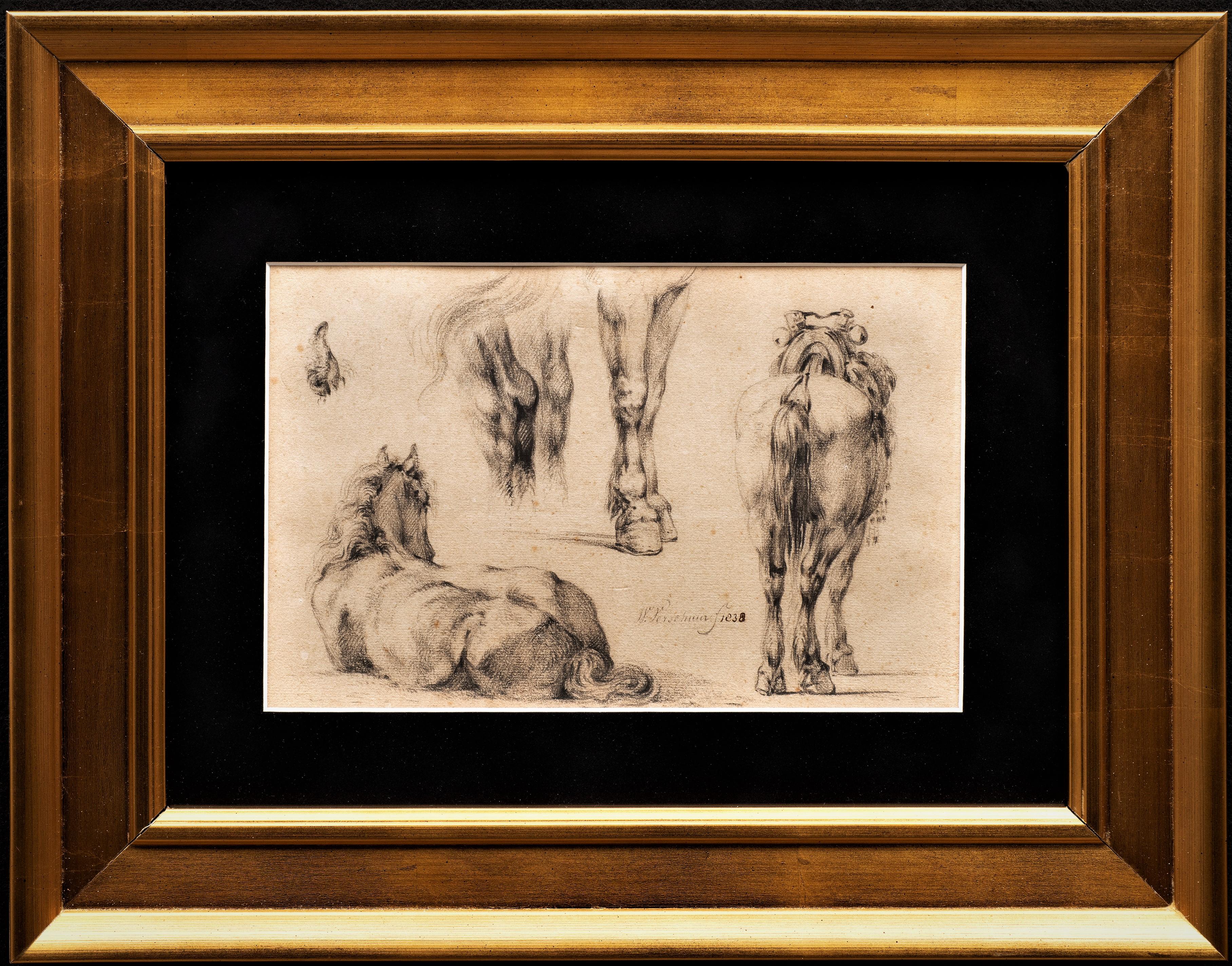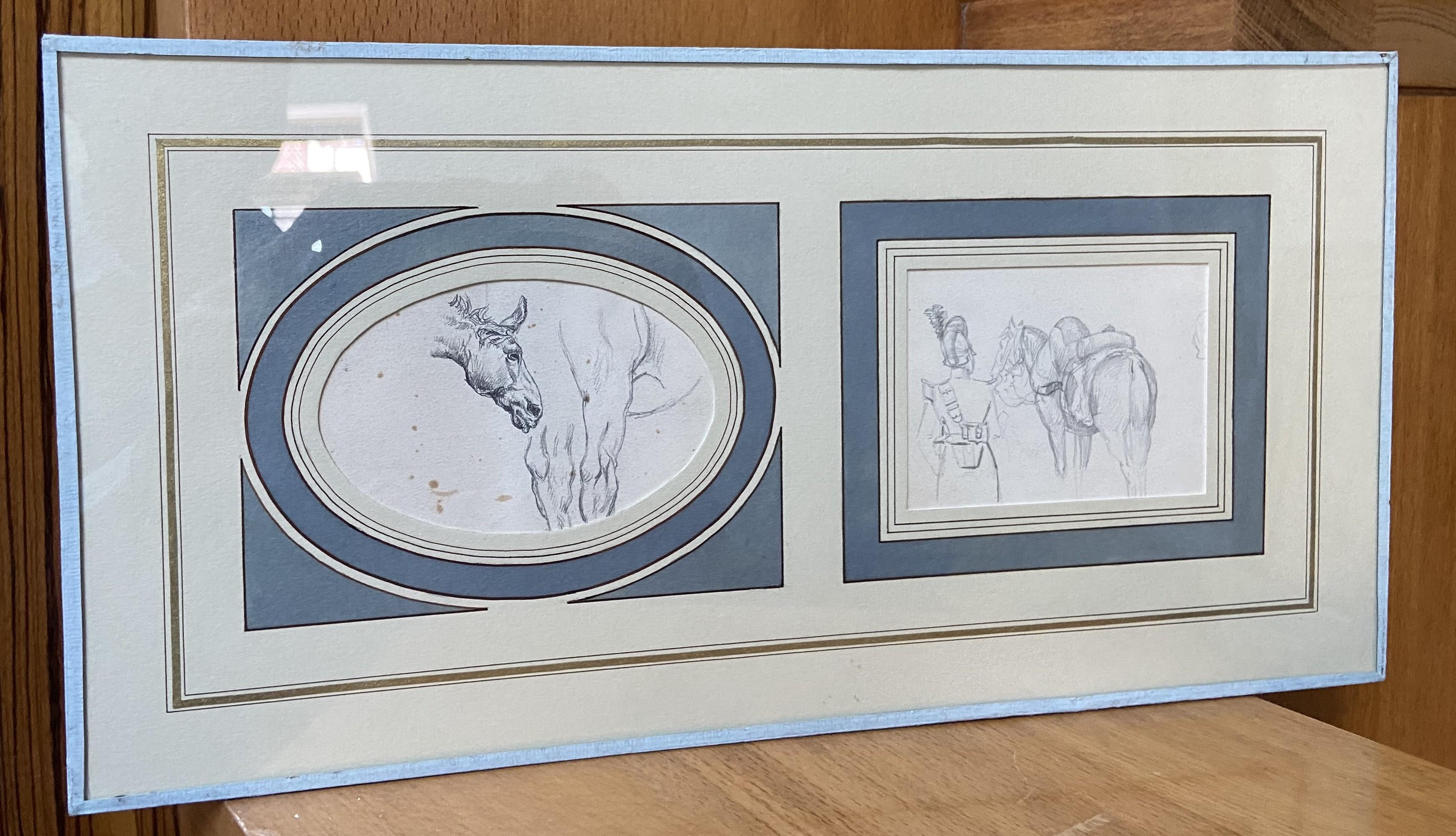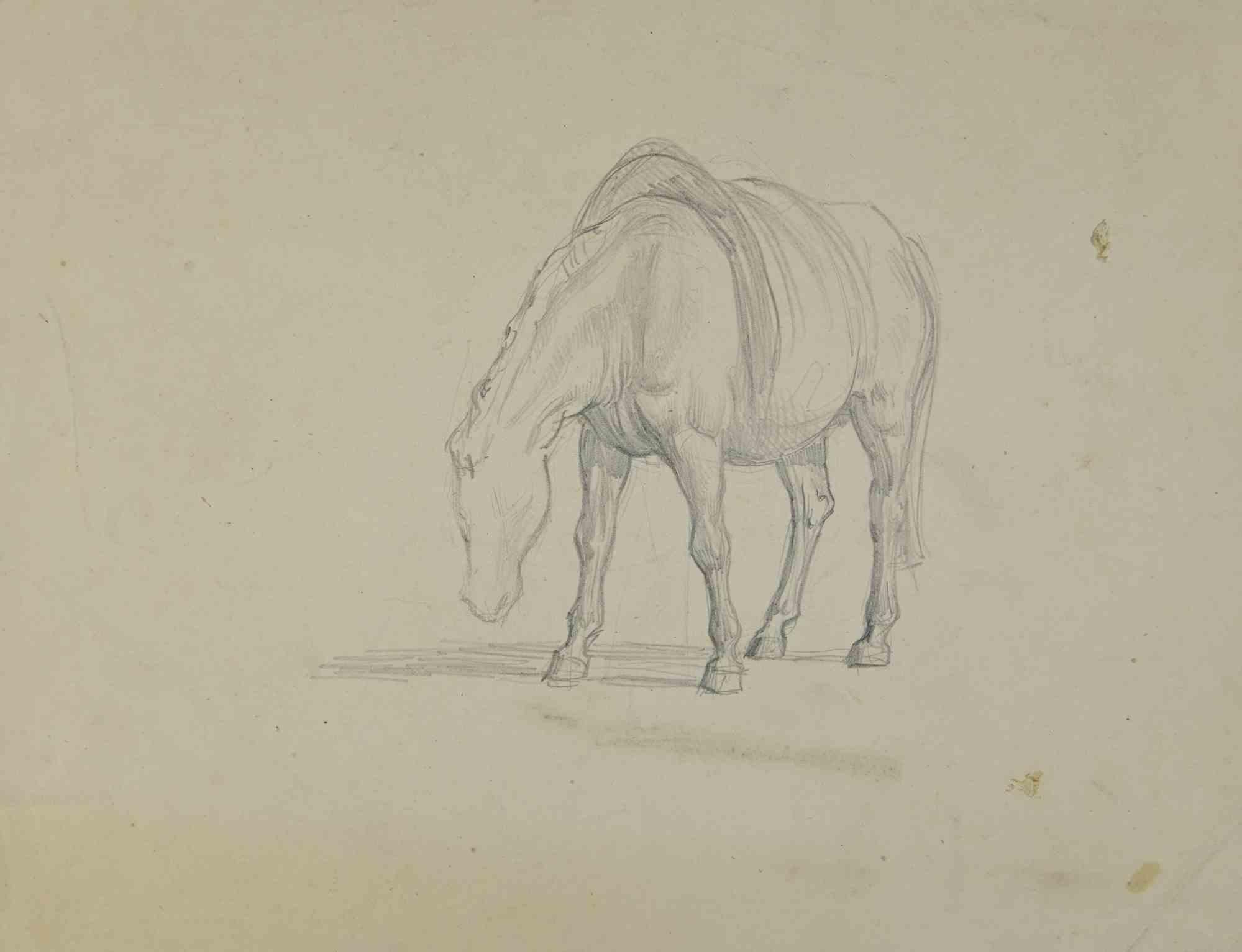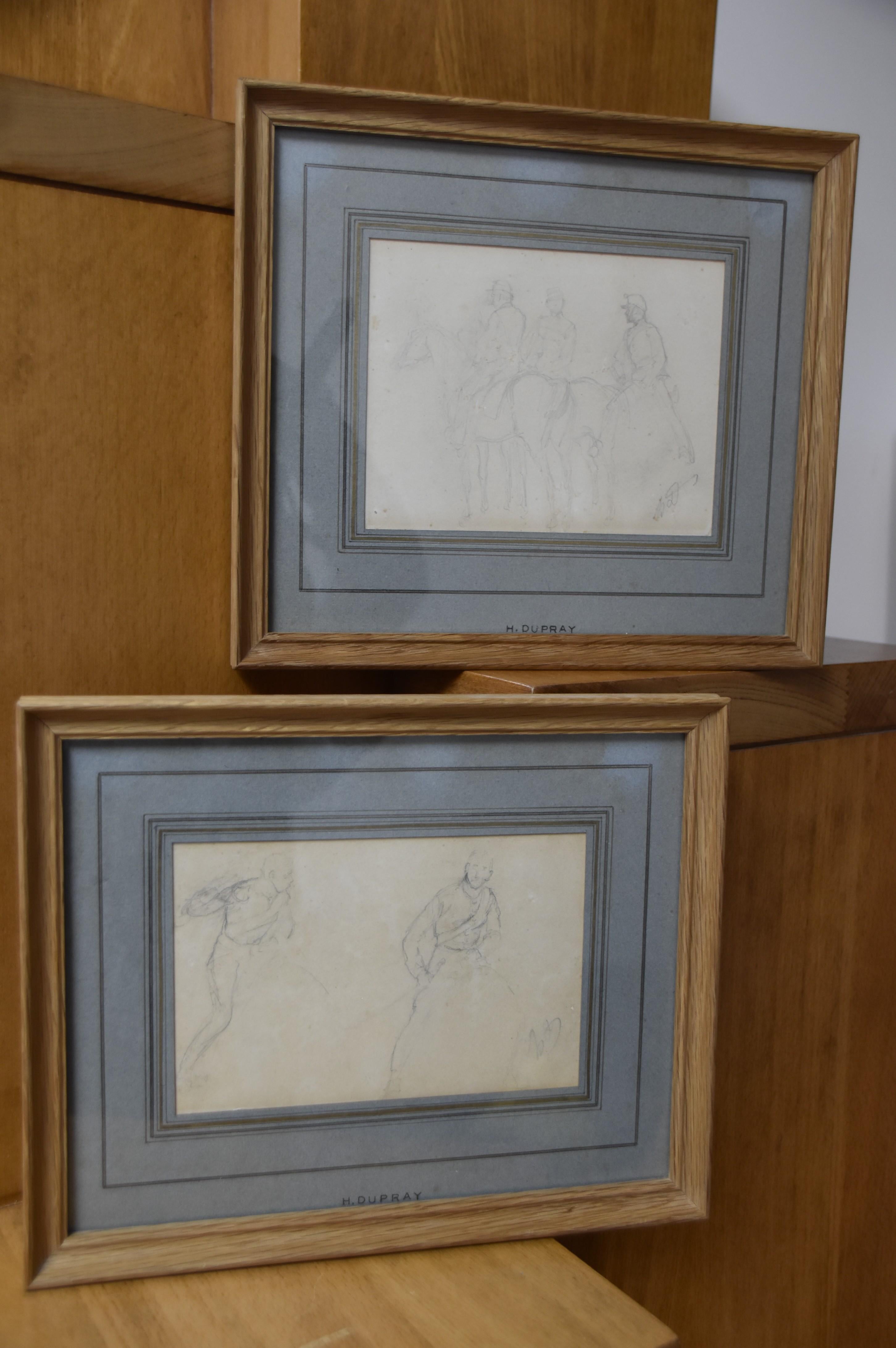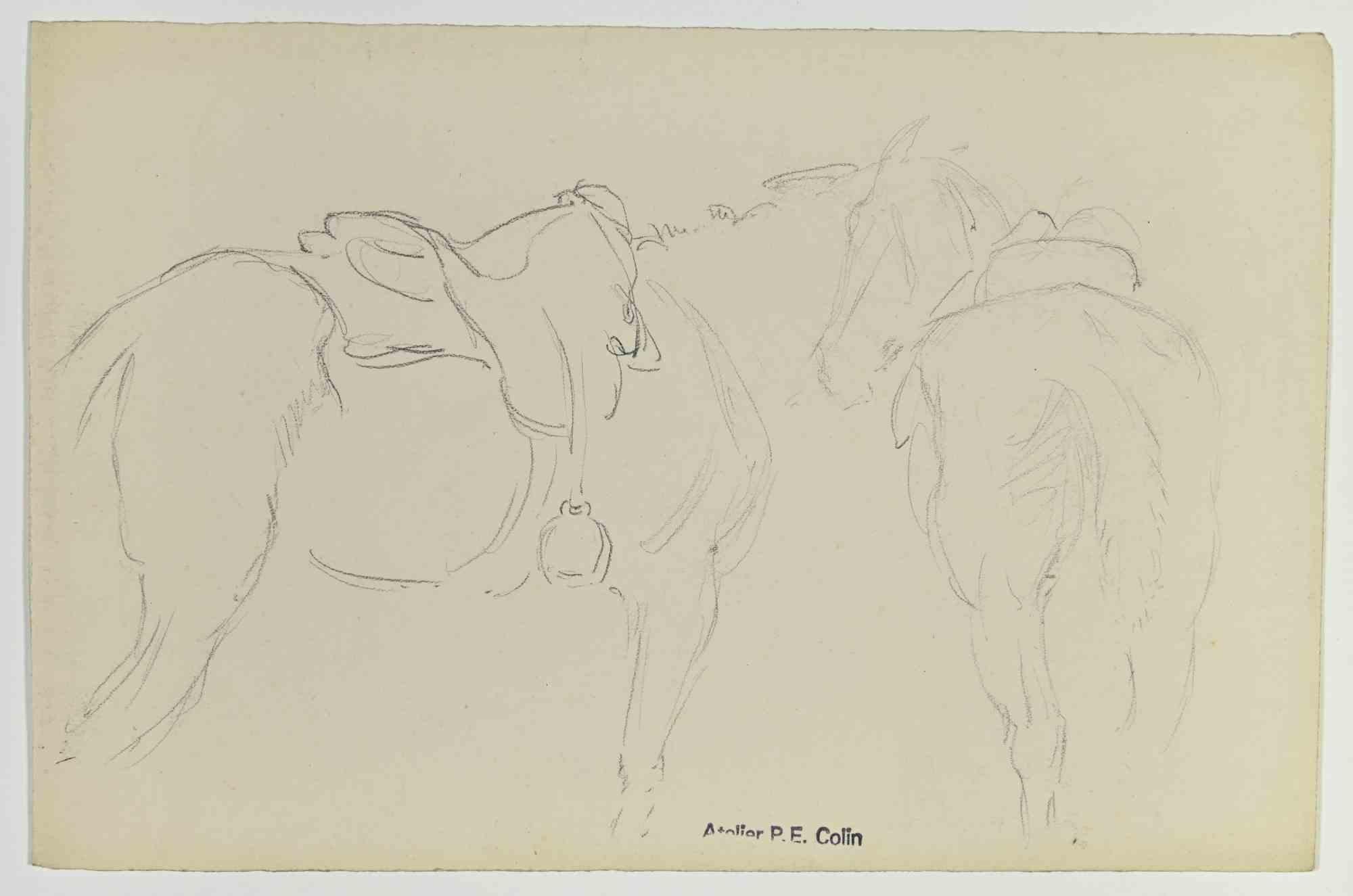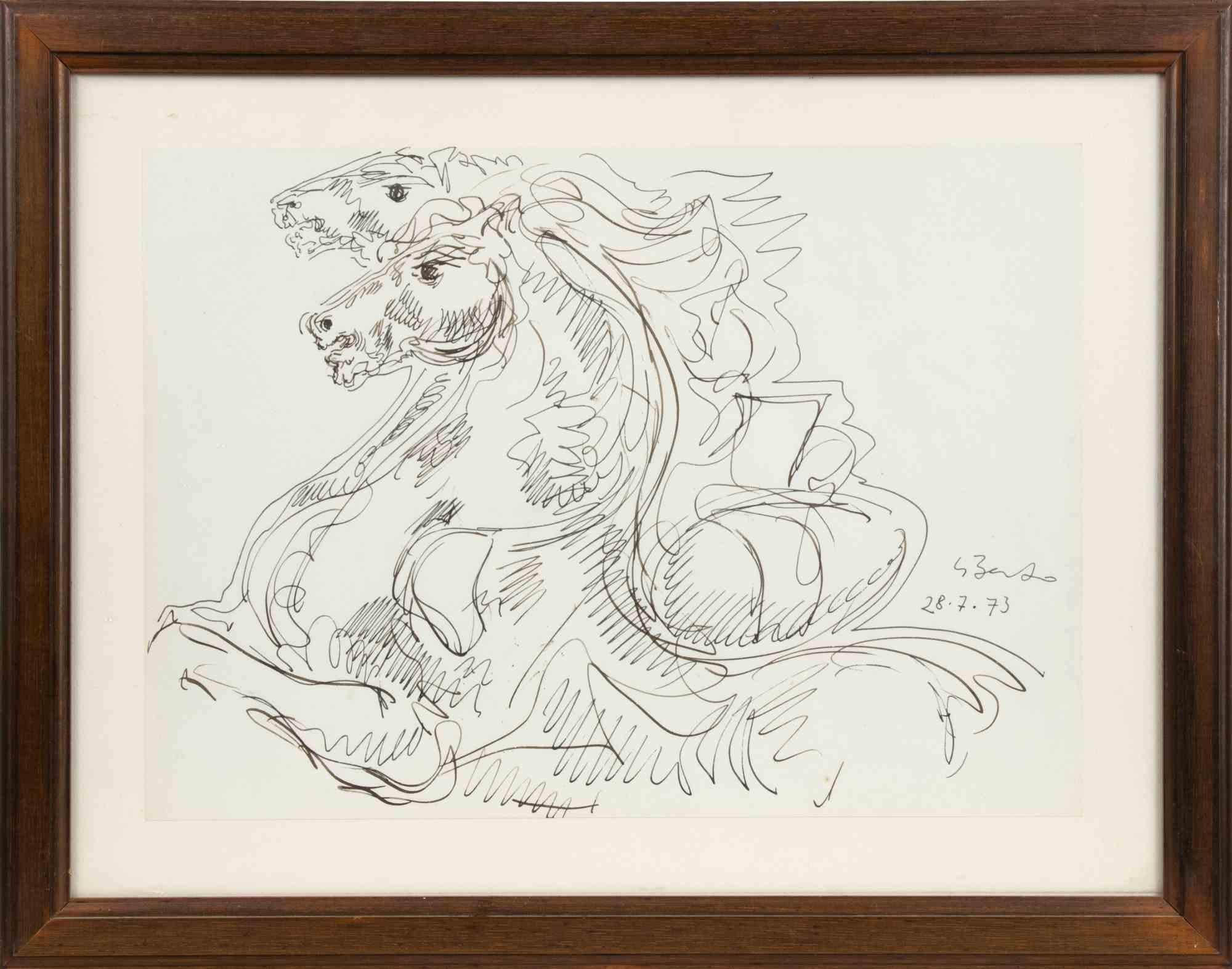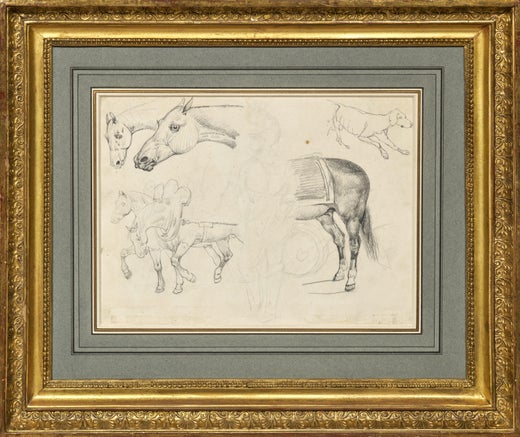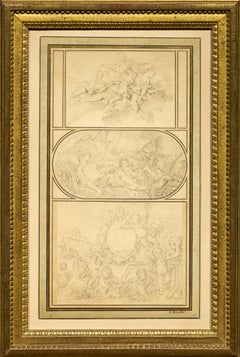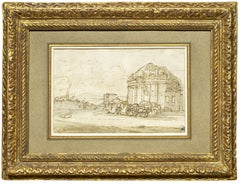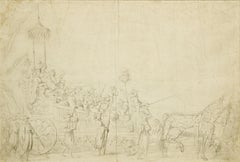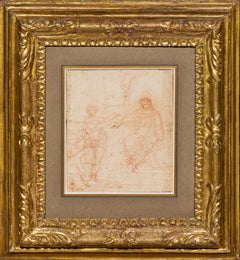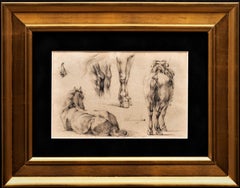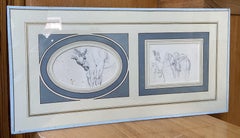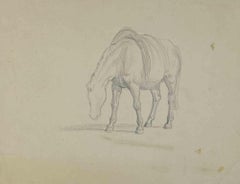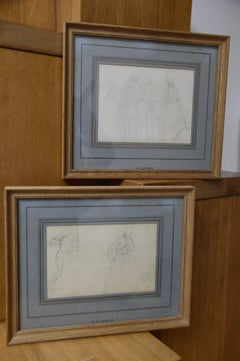Items Similar to Double-sided Horse Studies by Théodore Géricault
Want more images or videos?
Request additional images or videos from the seller
1 of 10
Jean Louis Andre Theodore GericaultDouble-sided Horse Studies by Théodore Géricault1820-1821
1820-1821
$45,000
£34,053.39
€39,274.24
CA$62,839.40
A$70,400.41
CHF 36,643.35
MX$857,342.23
NOK 466,787.39
SEK 439,582.01
DKK 293,177.21
Shipping
Retrieving quote...The 1stDibs Promise:
Authenticity Guarantee,
Money-Back Guarantee,
24-Hour Cancellation
About the Item
Recto: two horses, preparatory study for the lithograph "Les Boueux" ("The Muddy Ones")
Verso: four studies of horse heads (including two preparatory studies for the watercolor "Plowing in England"), a study of a life guard with the rump of his horse (preparatory to the lithograph "A Party of Life Guards") and a dog.
In these studies, probably executed during his stays in England in 1820-1821, Géricault reveals his fascination for horses. His pencil stroke is masterful, nervous and unrepentant. Two of them were later used in lithographic compositions published between 1821 and 1823, providing us with an insight into the artist's creative process.
While the most accomplished study for Les Boueux can be considered the recto of the sheet, the juxtaposition of the various studies on the verso, arranged around the ghostly figure of a life guard, creates a highly pleasing dynamic.
1. Théodore Géricault or the fiery life of a Romantic artist
Théodore Géricault was born in Rouen in 1791 into a wealthy family from the Manche region. His father, a magistrate and wealthy landowner, ran a tobacco factory. The family moved to Paris around 1796, and in 1810 Théodore Géricault entered Carle Vernet's studio, where he met his son Horace. He then studied with Pierre-Narcisse Guérin before enrolling on February 5, 1811 at the École des Beaux-Arts in Paris, where he pursued a classical training based on copying the masters at the Louvre Museum.
Géricault was expelled from the École des Beaux-Arts in 1812 for his misconduct; he then rented a back store on rue de la Michodière, where he painted one of his first masterpieces, a portrait of an officer of the imperial guard (the Lieutenant Dieudonné) charging while on horseback. This painting was exhibited at the 1812 Salon and won him the gold medal at the age of 21! Géricault became a sought-after painter, specializing in military subjects.
Géricault falled in love with his aunt Alexandrine Caruel de Saint-Martin (the wife of his mother's brother). Aged 28 years younger than her husband, she was only 6 years older than him. From this affair, which lasted for many years, a son Georges-Hippolyte was born in 1818.
After a short engagement in King Louis XVIII's Company of Grey Musketeers, Géricault, disappointed at not winning the Prix de Rome, spent two years in Italy. On his return in 1817, he embarked on the creation of his masterpiece, The Raft of the Medusa, which was exhibited in the Louvre in 1819 and was negatively received by the critics.
The presentation of the Raft in London in 1820 brought Géricault to the English capital, first for a two-month period between April and June 1820, then again in 1821 after a return to the continent and a stay in Brussels. The painting was triumphantly received in England (partly for the opposite political reasons to those that had led to its unsuccessful reception in France), and 50,000 visitors flocked to Bullock's gallery where it was exhibited during six months.
In November 1821, Géricault returned home very weakened by a venereal disease contracted probably during his stay in England. He fell off his horse several times, and in August 1823 broke his back in a fall. He died at the age of thirty-two on January 24, 1824, after a long agony.
2. Géricault's stays in England, a key stage in his career
Géricault's stays in England, where he was acclaimed by the press and received by the London Society, enabled him to discover both the work of the English landscape painters (Constable and Turner in particular) and horse racing, but also to explore the theme of horses in greater depth through his depiction of street scenes from London life.
In his book Les Chevaux de Géricault (Géricault's Horses), Bruno Chénique analyzes these representations of horses, which, in his view, go far beyond the simple representation of animals and constitute a strange psycho-physionomy of the artist: "the soul of a man, his instincts, his gentleness, his violence, his sexual and mortifying impulses".
3. Drawing description
While Géricault's graphic output is abundant, preparatory graphic elements for Géricault's prints published following his stay in England are quite rare.
The two horses depicted on the recto were later used in the lithograph "Les Boueux" (The Muddy Ones) published by Mrs Hulin in 1823 (in the Quatre sujets divers portfolio; seventh photo in the gallery). The sacks of oats covering the horses' heads have been removed in the final composition.
The various studies on the verso are organized around the ghostly silhouette (barely sketched in pencil) of a life guard shown on foot, next to his horse, whose rump has been studied in detail. This figure is faithfully reproduced in A Party of Life Guards (eigth photo in the gallery), one of the thirteen prints (including the title page) making up the "English portfolio" entitled Various Subjects Drawn from Life and on stone by J. [sic] Gericault, printed in London in 1821.
It is interesting to note that these studies of English military men are quite rare in Géricault's work: Germain Bazin's catalogue raisonné lists only three other ones, two of which are in public collections (at the Louvre and the Paris ENSB).
Two draught horses pulling a plough with a barely sketched wheel appear in the background of our life guard. These two horses are matching those in the background of the watercolour entitled Plowing in England (catalogue raisonné no. 2180, sold at Christie's on 11/15/1985) (last photo in the gallery).
On the top of the verso, we have two expressive horse heads and the quickly sketched silhouette of a dog. All of them evoke other works by Géricault but do not seem to be directly linked to any specific known artwork.
4. Framing
Our drawing is presented in a stuccoed and gilded wood frame from the first quarter of the 19th century. The drawing is included in a double-sided Marie-Louise and can be displayed on both sides.
Main bibliographical references
Germain Bazin, Théodore Géricault : Étude critique, documents et catalogue raisonné, Paris, La Bibliothèque des arts, Wildenstein Institute, Tome VII, 1997
Bruno Chenique, Les chevaux de Géricault, Bibliothèque de l'Image, Paris, 2002
- Creator:Jean Louis Andre Theodore Gericault (1791 - 1824, French)
- Creation Year:1820-1821
- Dimensions:Height: 7.5 in (19.05 cm)Width: 10.07 in (25.58 cm)
- Medium:
- Movement & Style:
- Period:
- Condition:7 ½” x 10 1/16” (19 x 25.5 cm) – Framed 14 3/16” x 16 ½” - (36 x 42 cm) Stuccoed and gilded wood frame with palmettes - First quarter of the 19th century.
- Gallery Location:PARIS, FR
- Reference Number:1stDibs: LU1568213079012
Jean Louis Andre Theodore Gericault
Théodore Géricault was born in Rouen in 1791 into a wealthy family from the Manche region. His father, a magistrate and wealthy landowner, ran a tobacco factory. The family moved to Paris around 1796, and in 1810 Théodore Géricault entered Carle Vernet's studio, where he met his son Horace. He then studied with Pierre-Narcisse Guérin before enrolling on February 5, 1811 at the École des Beaux-Arts in Paris, where he pursued a classical training based on copying the masters at the Louvre Museum. Géricault was expelled from the École des Beaux-Arts in 1812 for his misconduct; he then rented a back store on rue de la Michodière, where he painted one of his first masterpieces, a portrait of an officer of the imperial guard (the Lieutenant Dieudonné) charging while on horseback. This painting was exhibited at the 1812 Salon and won him the gold medal at the age of 21! Géricault became a sought-after painter, specializing in military subjects. Géricault falled in love with his aunt Alexandrine Caruel de Saint-Martin (the wife of his mother's brother). Aged 28 years younger than her husband, she was only 6 years older than him. From this affair, which lasted for many years, a son Georges-Hippolyte was born in 1818. After a short engagement in King Louis XVIII's Company of Grey Musketeers, Géricault, disappointed at not winning the Prix de Rome, spent two years in Italy. On his return in 1817, he embarked on the creation of his masterpiece, The Raft of the Medusa, which was exhibited in the Louvre in 1819 and was negatively received by the critics. The presentation of the Raft in London in 1820 brought Géricault to the English capital, first for a two-month period between April and June 1820, then again in 1821 after a return to the continent and a stay in Brussels. The painting was triumphantly received in England (partly for the opposite political reasons to those that had led to its unsuccessful reception in France), and 50,000 visitors flocked to Bullock's gallery where it was exhibited during six months. In November 1821, Géricault returned home very weakened by a venereal disease contracted probably during his stay in England. He fell off his horse several times, and in August 1823 broke his back in a fall. He died at the age of thirty-two on January 24, 1824, after a long agony.
About the Seller
5.0
Vetted Professional Seller
Every seller passes strict standards for authenticity and reliability
Established in 2020
1stDibs seller since 2021
10 sales on 1stDibs
Typical response time: 2 hours
- ShippingRetrieving quote...Shipping from: PARIS, France
- Return Policy
Authenticity Guarantee
In the unlikely event there’s an issue with an item’s authenticity, contact us within 1 year for a full refund. DetailsMoney-Back Guarantee
If your item is not as described, is damaged in transit, or does not arrive, contact us within 7 days for a full refund. Details24-Hour Cancellation
You have a 24-hour grace period in which to reconsider your purchase, with no questions asked.Vetted Professional Sellers
Our world-class sellers must adhere to strict standards for service and quality, maintaining the integrity of our listings.Price-Match Guarantee
If you find that a seller listed the same item for a lower price elsewhere, we’ll match it.Trusted Global Delivery
Our best-in-class carrier network provides specialized shipping options worldwide, including custom delivery.More From This Seller
View AllThree drawings by François Boucher in a mounting by Jean-Baptiste Glomy
By François Boucher
Located in PARIS, FR
We would like to thank Juliette Parmentier-Courreau of the Custodia Foundation for her welcome and support during the consultation of Glomy’s Journal des Ouvrages.
This spectacularly large "feuille de desseins ajustés" commissioned by François Boucher from Jean-Baptiste Glomy is emblematic of the painter's art and mastery of rocaille. It is also fully representative of the taste of this period in the field of decorative arts. The largest of these three drawings, placed at the bottom of the composition, is particularly interesting: dating from around 1756, it constitutes a modello (apparently unpublished) for the frontispiece of the "Catalogue des tableaux de Monsieur de Julienne"), preserved in the Morgan Library in New York.
1. François Boucher, the master of French rocaille
The extraordinary career of Francois Boucher was unmatched by his contemporaries in versatility, consistency and output. For many, particularly the writers and collectors who led the revival of interest in the French rococo during the last century, his sensuous beauties and plump cupids represent the French eighteenth century at its most typical. His facility with the brush, even when betraying the occasional superficiality of his art, enabled him to master every aspect of painting – history and mythology, portraiture, landscape, ordinary life and, as part of larger compositions, even still life. He had been trained as an engraver, and the skills of a draftsman, which he imbued in the studio of Jean-Francois Cars (1661 – 1738), stood him in good stead throughout his career; his delightful drawings are one of the most sought-after aspects of his oeuvre.
As a student of Francois Lemoyne (1688 - 1737), he mastered the art of composition. The four years he spent in Italy, from 1727-1731, educated him in the works of the masters, classics and history, that his modest upbringing had denied him.
On his return to Paris in 1734, he gained full membership of the Royal Academy of Painting and Sculpture with his splendid Rinaldo and Armida (Paris, Musée du Louvre). Although, throughout his career, he occasionally painted subjects taken from the Bible, and would always have considered himself first as a history painter, his own repertoire of heroines, seductresses, flirtatious peasant girls and erotic beauties was better suited to a lighter, more decorative subject matter. His mastery of technique and composition enabled him to move from large scale tapestry...
Category
1750s Old Masters Figurative Drawings and Watercolors
Materials
Chalk, Ink
A landscape drawing by Claude Lorrain, with a preliminary sketch on the verso
By Claude Lorrain
Located in PARIS, FR
This study presents a typical Roman countryside landscape: an ancient mausoleum in front of which a cart is passing by followed by two peasants. If the technique (a pen drawing on graphite lines, completed with a wash of brown and grey inks) and the signature inevitably evoke the art of Lorrain, we find on the verso of this drawing additional evidences that lead us to consider this unpublished drawing as a work by the master.
The motif of the mausoleum has been taken up in pen on the verso in a technique that can be found in several other drawings by Lorrain. There is also a study of three characters, which can be considered as preparatory to Lorrain’s painting entitled The Port of Ostia with the Embarkation of Saint Paula, leading us to claim this attribution with a dating of around 1639.
1. Claude Lorrain or the perfection of classical landscape in Rome in the 17th century
Claude Gellée was born in 1600 in Chamagne in Lorraine. Orphaned at the age of twelve, he spent a year with his brother in Freiburg, where the latter was a woodcarver. Claude Gellée then probably arrived in Rome in 1613, where he joined the workshop of Agostino Tassi (1580 - 1644) in 1617. Between 1619 and 1620 he studied for two years in Naples in the workshop of Goffredi Wals (who was himself a former pupil of Tassi).
In 1625 he returned to Lorraine for two years where he worked alongside Claude Deruet. He then returned to Rome, a city he never left for the rest of his life (except for short trips to the surrounding countryside).
From 1627 to 1650 he lived in Via Margutta. From 1635 onwards he became a renowned painter and commissions started to pour in. Considered during his lifetime as the most accomplished of the classical landscape painters, his reputation never faded.
Between 1629 and 1635 Le Lorrain often went to the Roman countryside to draw with his friend Joachim von Sandrart (1606 - 1686). He became a member of the Academy of Saint Luke in 1633, while being closely acquainted with the Bentvueghels, this guild which brought together the young Nordic painters active in Rome. In 1643 he joined the Congregation of the Virtuosi. In 1650 he moved to Via Paolina where he lived until his death.
Little is known of his intimate life. He seems to have had a daughter, Agnes, from an ancillary love affair. In 1657/ 1658 she moved in with him. Stricken with gout in 1663, he died in 1682.
2. Description of the drawing; the technique of nature studies
Two peasants are walking behind a horse-drawn cart on a road that winds through ancient tombs. While a rectangular tomb with a columned facade can be seen in the distance, the cart passes an important ancient building. It has a circular shape and its partially ruined façade is decorated with columns. The start of a second floor can...
Category
1630s Old Masters Landscape Drawings and Watercolors
Materials
Ink, Pen, Graphite
Study for « The Chinese Masquerade » by Jean-Baptiste Pierre (1714 - 1789)
By Jean-Baptiste Pierre
Located in PARIS, FR
Arriving in Rome in June 1735 as a resident at the Royal Academy, Pierre was unable to attend the Winter Carnival festivities of 1735, which he nevertheless immortalised in an engrav...
Category
1730s Old Masters Figurative Drawings and Watercolors
Materials
Graphite
Studies for the Judgment of Solomon, a double-sided drawing by Simone Cantarini
Located in PARIS, FR
In this double-sided red chalk study, Simone Cantarini offers us a double reflection on the theme of the Judgment of Solomon. This sheet reveals his precise style and his sense of de...
Category
1640s Old Masters Figurative Drawings and Watercolors
Materials
Chalk, Laid Paper
Pair of Prancing Horses, two bronzes signed and numbered by Arno Breker
Located in PARIS, FR
An official artist of the Nazi regime, trained in Montparnasse in the 1930s, Arno Breker continued to sculpt after the fall of the Third Reich, producing large-scale public commissions in Germany and portraits of prominent figures. The two small bronzes presented here, dated around 1978, are part of a long tradition of prancing horses dating back to antiquity. The asymmetrical treatment of the two front legs and the inclination of the head make these two copies of the same artwork a highly decorative pair.
1. Arno Breker, a prolific sculptor, from the Bohemia of Montparnasse to the commissions from the Third Reich ... and from the Federal Republic of Germany
The son of a stone carver, Arno Breker studied fine art and anatomy in his native Elberfeld. At the age of 20, he entered the Düsseldorf Academy of Art. He moved to Paris in 1926, where he continued his training in the studio of Maillol, who dubbed him "the German Michelangelo of the twentieth century". He shared a studio with Alexandre Calder and frequented Jean Cocteau, Foujita, Brancusi, Pablo Picasso and other artists of the bohemian Paris of the time. It was also in Paris in 1933 that he met Demetra Messala, the daughter of a Greek diplomat who posed for Maillol and Picasso, whom he married in 1937. Having won the Prussian Prix de Rome in 1932, he left Paris to stay at the Villa Massimo, the German Academy in Rome.
Returning to Germany in 1934, his style evolved towards a more marked imitation of ancient sculpture. He created two monumental statues for Berlin's Olympic Stadium, before being appointed professor at the Berlin College of Fine Arts in 1937. He came to the attention of the Reich Propaganda Ministry, which awarded him several commissions and provided him with three large studios in which Breker produced many monumental sculptures to the glory of the regime. On June 23, 1940, Breker accompanied Adolf Hitler during a visit to Paris. During the Occupation, his political connections enabled him to intervene on behalf of many artists pursued by the Nazis: for example, he protected Pablo Picasso (then a Communist) from Kommandantur officers.
Most of Arno Breker's work was destroyed in Berlin at the end of the war in 1945 by bombing and intentional destruction perpetrated by soldiers of the victorious powers. After the fall of the Nazi regime, however, Arno Breker was never prosecuted. He opened a new studio in Düsseldorf, where he sculpted until his death in 1991.
He then carried out several public commissions in Germany (Bayreuth, Wuppertal), as well as portraits of numerous personalities, including King Mohammed V of Morocco, Léopold Sedar Senghor (commissioned by the Académie Française in 1978) and the two chancellors of the Federal Republic of Germany, Konrad Adenauer and Ludwig Erhard. The Arno Breker Museum in Nörvenich is now exhibiting some of his artworks.
2. Related artworks: from the Wild Horses of the Quirinal to the Horses of Marly
The prancing horse is a major iconographic theme, found in a series of sculptures from Antiquity, the Renaissance and the Classical Age. Various photos from Arno Breker's studio in Berlin confirm the predominant place of equine representations in his work (alongside male nude statues), and confirm that this reduced version created in 1978 is part of the artist's preferred repertoire.
Prancing horses are generally associated with a male figure in a group that, through a reference drawn from Antiquity, symbolizes man's domination over nature. In this respect, it is very interesting to compare our small bronzes with the horse forming part of a large sculpture by Arno Breker (made in 1936 and probably destroyed in 1945) depicting Alexander taming Bucephalus.
This statue is itself directly inspired by one of the best-known works of 18th-century French sculpture...
Category
1970s Art Deco Figurative Sculptures
Materials
Bronze
Frieze of antique figures, a drawing by the sculptor Antoine-Denis Chaudet
Located in PARIS, FR
Faithful to the neo-classical taste, sculptor Antoine-Denis Chaudet presents us with a frieze of antique figures executed in gray wash over pencil strokes, which is likely inspired b...
Category
Early 1800s Old Masters Figurative Drawings and Watercolors
Materials
Paper, Pencil, Ink
You May Also Like
Antique Horse Study; Legs and Rumps, 1838" Wouterus Verschuur (Dutch, 1812-1874)
Located in SANTA FE, NM
Antique Horse Study
"Legs and Rumps, 1838"
Wouterus Verschuur l (Dutch, 1812-1874)
Pencil on paper
Signed and Dated "W Verschuur 1838"
10 x 6 1/2 (17 1/2 x 14 frame) inches
In his time Wouterus Verschuur was an acclaimed and celebrated painter of horses. Through careful observation he learned to capture their physique and movement to perfection. As a true-born romanticist he was also interested in their character, thereby painting powerful carthorses in their stable, thoroughbred saddled horses during an afternoon ride or harnessed horses in action.
He was born to an Amsterdam jeweler and received his training from the landscape and cattle painters Pieter Gerardus van Os and Cornelis Steffelaar. As part of this education Verschuur had to copy works by the 17th century painter Philips Wouwerman. Like Wouwerman, Verschuur's subjects consist mostly of stable scenes, landscapes with horses and coastal landscape. These works reflect the enduring influence of the northern Baroque masters on nineteenth century art, revealing the artist's close study of his Dutch and Flemish predecessors harking back to Peter Paul Rubens.
Showing talent from a very early age, at 15 Verschuur had a painting exhibited at the "Exhibition of Living Masters" at Amsterdam in 1828. In 1832 and 1833 he won the gold medal at the annual exhibition at Felix Meritis. In 1833 he was appointed a member of the Royal Academy in Amsterdam. In 1839 he joined the artists' society, Arti et Amicitiae.
His reputation was also considerable abroad. He was often featured in the annual exhibitions which travelled the large European cities at that time. In 1855 Napoleon III purchased one of his paintings at the Exposition Universelle in Paris.
The Verschuur horse revels in its physicality, like a quintessential Baroque horse...
Category
1830s Romantic Animal Drawings and Watercolors
Materials
Pencil, Paper
French School 19th Century, Studies of horses, two drawings
Located in Paris, FR
French School 19th Century,
Studies of horses,
two drawings in the same frame
7 x 11 cm (oval) and 7 x 9.8 cm
pencil on paper
Condition : The oval one on the left with foxings (see...
Category
1880s Academic Animal Drawings and Watercolors
Materials
Pencil
$204 Sale Price
30% Off
Horse - Drawing by Joseph Alexander Colin - Mid-20th Century
Located in Roma, IT
Horse is a drawing realized by Joseph Colin in the Mid-20th Century.
Pencil on ivory-colored paper
Good conditions with slight foxing.
The artwork is realized through deft express...
Category
Mid-20th Century Modern Figurative Drawings and Watercolors
Materials
Pencil, Paper
Henri-Louis Dupray (1841-1909) Studies of military horsemen, two signed drawings
By Henry Louis Dupray
Located in Paris, FR
Henri-Louis Dupray (1841-1909)
Studies of military horsemen, two signed drawings
Pencil on paper
The first one figuring a partial study of two horsemen :
10.8 x 16.5 cm, bears a mo...
Category
1880s Romantic Animal Drawings and Watercolors
Materials
Pencil
Horses - Drawing by Paul Emile Colin - Early-20th century
Located in Roma, IT
Horses is a drawing realized by Paul Emile Colin in the Early 20th Century.
Carbon Pencil on ivory-colored paper
Stamped on the lower.
Good conditions with slight foxing.
The art...
Category
Early 20th Century Modern Landscape Drawings and Watercolors
Materials
Pencil
Horses - Drawing by Gianpaolo Berto - 1973
By Gianpaolo Berto
Located in Roma, IT
Horses is a modern artwork realized by Gian Paolo Berto in 1973.
China ink drawing on paper.
Hand signed and dated by the artist.
Includes frame.
Category
1970s Contemporary Animal Drawings and Watercolors
Materials
Ink
More Ways To Browse
Horse Photo
Dior Horse
Man And Horse Painting
Old Master Sketch
Horse Head Painted
Horse Painting Italian
Old Master Pencil Drawing
Military Horse
Horse And Dog
Horse Painting Gold Frame
Horse Painting Old Masters
Four Horse Paintings
Pencil Drawings Of Horses
Horse Racing Paint
Horse Portrait 19th Century
Horses And Dog Art
Horse Dog Painting
Horse And Dog Painting
